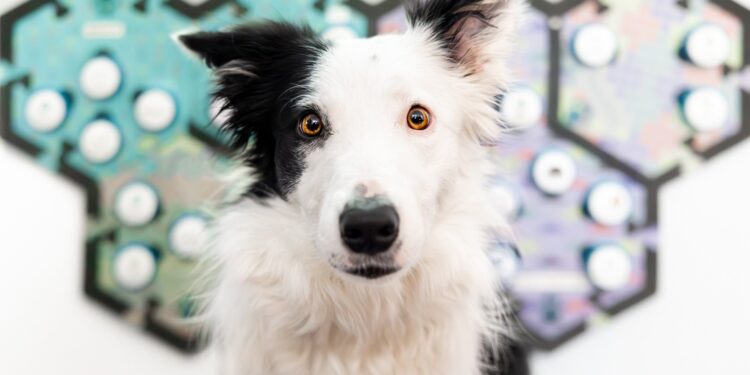Dog and soundboard from a study of pet communication conducted by the Comparative Cognition Lab at the University of California, San Diego. Credit: Christopher Wood, courtesy of the Comparative Cognition Lab at the University of California, San Diego.
If you’ve seen those viral videos on social media of dogs using mixer buttons to “talk,” you’re not alone. These buttons have taken the pet world by storm, leading to impressive and sometimes seemingly miraculous feats shared on platforms like TikTok and Instagram. But are these dogs actually communicating, or are they just responding to their owners’ cues?
Now, a study published in PLOS ONE—by researchers at the University of California, San Diego and other institutions—reveals that dogs trained with soundboard buttons can actually understand specific words, producing contextually appropriate responses.
Led by Federico Rossano, associate professor in UC San Diego’s Department of Cognitive Science and head of the Comparative Cognition Lab, it is the first empirical study to emerge from the world’s largest longitudinal project on button-trained pets.
Rossano, who also appears in the popular new Netflix documentary “Inside the Mind of a Dog,” emphasizes that this research is just one step in his lab’s ongoing investigation into interspecies communication.
Main conclusions
The study found that dogs trained to use mixers responded appropriately to words like “play” and “outside,” whether the words were spoken by their owner or triggered by the press of a button, and whether the buttons were pressed by the owner or an unrelated person. This suggests that dogs aren’t just “reading” their owner’s body language or presence, but are actually processing the words.
“This study addresses public skepticism about whether dogs truly understand the meaning of buttons,” Rossano said. “Our findings are important because they show that words matter to dogs and that they respond to the words themselves, not just the cues associated with them.”
The study consisted of two complementary experiments. The first was conducted in person, with researchers visiting the homes of 30 dogs across the country to test their responses to the mixer buttons. The second experiment used citizen science, with 29 dog owners conducting the tests themselves at home under remote supervision.
The study methodology was rigorously pre-registered, ensuring transparency and reproducibility. This pre-registration, publicly available online, describes the study hypotheses, data collection methods, variables, and analysis plans before any data collection.
This process, Rossano explained, strengthens accountability, reduces the risk of cherry-picking of results, and aligns with a growing movement in cognitive science and psychology to increase scientific rigor and reduce the likelihood of bias or fraud.
Rossano added: “We have only scratched the surface with this study. Future studies will explore how dogs actively use these buttons, including the meaning and systematicity of button press sequences. Our research highlights the importance of studying animals in their domestic environment, providing a more ecologically valid understanding of their abilities.”
This study is part of a larger, ongoing research project involving thousands of participants around the world. Future research will delve deeper into how dogs spontaneously use the soundboard buttons, shedding more light on the complexities of canine cognition and communication.
The study’s lead author is Amalia Bastos, a former postdoctoral fellow at the University of California, San Diego, now a postdoctoral fellow at Johns Hopkins University. The study was also conducted in collaboration with researchers from the University of California, Davis, the University of St. Andrews, the University of Valencia, and the University of Veterinary Medicine Vienna.
The study data were collected in 2022 during the omicron wave of the COVID-19 pandemic, with participants generously opening their homes to researchers, highlighting the growing public interest and engagement in citizen science.
More information:
How do soundboard-trained dogs respond to human button presses? An investigation into word comprehension, PLoS ONE (2024). DOI: 10.1371/journal.pone.0307189. journals.plos.org/plosone/arti …journal.pone.0307189
Provided by University of California – San Diego
Quote: Dogs Understand Words Through Mixing Console Buttons, Study Finds (2024, August 28) retrieved August 29, 2024 from
This document is subject to copyright. Apart from any fair dealing for the purpose of private study or research, no part may be reproduced without written permission. The content is provided for informational purposes only.



